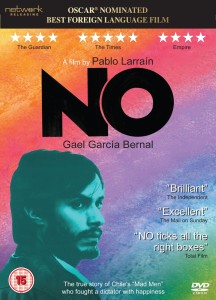How to win a referendum: lessons from Chile and the power of happiness
In 1988 then Chilean ruler and long-time violent dictator General Pinochet had to hold a referendum on whether or not he should continue in power. The brilliant film No, very closely based on real events, follows the man (actually two men in real life conflated into one for the film) in charge of the anti-Pinochet campaign’s advertising which, with 15 minutes allocated to each campaign daily on TV, was central to the referendum.
 As the blurb on the DVD cover puts it, No is “the true story of Chile’s ‘Mad Men’ who fought a dictator with happiness”. It’s also packed full of highly relevant lessons for other referendums, and indeed elections in general.
As the blurb on the DVD cover puts it, No is “the true story of Chile’s ‘Mad Men’ who fought a dictator with happiness”. It’s also packed full of highly relevant lessons for other referendums, and indeed elections in general.
An early dilemma was whether or not to take part in a referendum which many anti-Pinochet campaigners feared would be rigged against them. Would taking part be doomed to failure and simply give the referendum false credibility? Whether or not to take part in a political system you do not support – such as elections for posts you don’t believe in or appointments to bodies you believe should be elected – is a regular political question. Best to take part in the hope of making a difference or boycott and hope that undermines the system?
Another dilemma was how hard to push the record of Pinochet’s appalling human rights abuses. For some the idea of having 15 minutes of national TV each day – an unprecedented volume of coverage for the opposition – and not using it to heavily cover those abuses would have been an insult to the victims. It would have been a failed opportunity to publicise what had really happened in their own country.
As the advertising man played by Gael Garcia Bernal, however, points out such a strategy would fail to appeal to the two, almost contradictory, audiences the No campaign had to win over.
First, young voters who were heavily anti-Pinochet but who might not vote. How would repeatedly reminding them of the ways in which Pinochet had abused rules to hang on to power encourage them to go out and vote? Second, older voters whose own lives were moderately prosperous and peaceful. What would make them feel that introducing democracy would be a good move rather than a risky introduction of instability? Angry denunciations of all the Pinochet stood for risked driving them away and into voting for Pinochet to stay in power.
The answer was to have a positive campaign, emphasising how good the future for Chile could be with Pinochet gone. One of the film’s best scenes is the attempt to turn this idea into a message, searching for the right, happy image for the future. As is said in the film, with echoes of all the worst cliches of advertising: ‘what is happier than happiness?’ Hence a campaign based on a rainbow, lots of singing and the line ‘happiness is coming’ rather than on grim reminders of the past. (In real life, the campaign message did indeed go for positive and hope, rather than negative and fear, but it came out of focus group research run with the help of American consultants and funding. As Frank Grear, who was one of those who travelled regularly to Chile, said “[the focus groups] proved that if you want to win, it’s necessary to have a moderate message. And of course, we have some people to the far left who say, well, I don’t agree with this, so they were put out of the coalition”.)
The advertising clips shown in the film (both real and recreated) are almost embarrassingly twee when viewed without knowledge of this campaign logic – and still pretty wince inducing to modern eyes even when you appreciate the cleverness of a strategy that reconciled appealing to two such disparate groups. But they were effective.
Everyone could impute their own version of happiness into the campaign’s vision of the future, making that key campaign message of hope work well across the board. Just as Barack Obama’s successful 2008 ‘Hope’ campaign for the US Presidency similarly let very diverse groups of voters all project their own versions of hope on to his campaign.Aside from the political lessons, the film is great entertainment and also a good light on how advertising was adapting to the modern TV world.
If you like this, you might also be interested in A Face in the Crowd. Or for more on how to win elections, there is 101 Ways To Win An Election.
Leave a Reply